It was very close and stuffy when we went to sleep last night. During the night it rained heavily and continued for most of today. The temperature has dropped from around 30 degrees yesterday to 13 today and we have needed the heater on as we drove the wet, misty routes through the mountains.
Driving in Austria feels very calm after Italy but the roads have been fairly empty as we made our way to Graz, Austria's largest city after Vienna. We expected the journey to be far more hectic. At the top of a pass we stopped for a coffee and a rest at the village of Preitenegg. The views are supposed to be spectacular but there was too much mist for us to see much. In the bar of the village Bierstube we shared a table with the local policeman, his mobile phone and his gun. We doubt he could ever be overworked in such a smart, clean and disciplined little village.
 View from the village of Preitenegg
View from the village of PreiteneggThat's Austria - immaculate! People must spend Sundays on their knees with nail scissors trimming their lawns it all looks so tidy. The streets are equally well tended. Near our present campsite we saw signs warning against parking cars as the streets were to be cleaned today between 9am and noon. That's how organised everything is. And using the public toilets becomes something to look forward to! No Turkish holes in the ground here! There are even seats and loo paper. Not only are there hand basins, there is even HOT water, soap and paper hand towels! Public facilities in Italy, Spain and Portugal were rarely good and in France they were generally awful. Here though they are an experience to be relished.
I digress. Around 3pm we arrived in Graz and found the campsite, attached to a huge outdoor swimming pool. Free access is a perk of staying at the site. However, it is cold, wet and raining so nobody wants to use it today. The campsite looks very bedraggled and waterlogged too and it is rather expensive. It is convenient for visiting Graz though with buses every fifteen minutes to the centre of the town. A friendly lady at the bus stop told us we should buy weekly bus tickets as they work out at a fraction of the price of buying single ones and sent us off to the tobacconist to purchase a couple. For eight euros we have tickets for a week and can use the entire city transport system of buses, trams and funiculars. We will definitely be around for a few days so it was worth buying them.
We are here because our friend and work colleague Mike Maguire made us promise to come. By a strange twist of fate, he and Vicki will be arriving tomorrow. Until last night we none of us had any idea the other would be here! So all being well we have arranged to meet up on Saturday when Mike intends giving us a tour of the city's most notable Wurst and ice cream outlets!
The rain eased slightly so we took the bus into town for a preliminary look around. Streets in the old town are wide and free from cars, with delightful old trams making their way slowly around the centre. During the war a huge outcrop of dolomite in the centre of Graz was honeycombed with caves and tunnels offering shelter to the residents of the town in case of air raids. Now the tunnels have a new life with bars, night clubs and restaurants deep inside the mountain and a lift and a railway using the tunnels to take people up to the remains of the Schloss on the top. We walked through one of these tunnels to emerge on the opposite side of the hill and walked down to the centre again past the Hauptplatz, a large open square and along the Herrengasse, lined with buildings with baroque facades.
 Baroque houses and the fountain on the Hauptplatz, Graz
Baroque houses and the fountain on the Hauptplatz, Graz The Landhaus on the Herrengasse, Graz
The Landhaus on the Herrengasse, Graz The Renaissance courtyard of the Landhaus, Graz
The Renaissance courtyard of the Landhaus, Graz The Landeszeughaus on the Herrengasse, Graz, a world famous armory
The Landeszeughaus on the Herrengasse, Graz, a world famous armoryThere appear to be a number of interesting museums and galleries if the rain continues though it is surprising how restricted their opening hours are. The working day seems to start and end very early. Shops are open at 7am and generally seem to close around 6pm. Even supermarkets are shut by 7pm. It takes getting used to after Spain and Italy where everywhere is in full swing until late into the evening.
There is one museum though that we are sure to be able to visit as it is open 6am until 10pm. Film star and Governor of California Arnold Schwarzenegger is one of Graz's most illustrious children and there is a museum of his body-building equipment freely open to the public. Now Ian of course has always held Arnie in high esteem regarding him as his role model when it comes to his own physique and fitness. So he is just longing to take the rattling old tram out from the city centre to gaze in awe at photos of his hero and try out his weights, dumb bells and bull-worker!
Thursday 25th May 2006, Graz, Austria
Sunshine greeted us this morning and we were able to breakfast outside Modestine though the grass was still completely waterlogged. The local supermarket is supposed to open at 7am but when we arrived at 8 to buy fresh rolls we found it shut. The streets were deserted as we took the bus into town and everywhere was completely silent in the city centre – a rather strange experience. We found the internet shop open however and sorted out emails and loaded a new blog. The young man running the shop said he thought it might be a national holiday of some sort but didn't know what, he just opened as usual! It is a religious holiday in fact but we don't know what either, possibly Ascension day. It does explain why we were woken by the bells of the baroque church on the hill above our campsite clanging away at 7am. We have also seen several children dressed in white around the town so presume they have just taken their first communion.
Such an early start and no proper breakfast meant we were really hungry by 11.30am. There is a permanent smell of frying over the entire city centre and all the bars, restaurants and cafes were open as usual. A fish restaurant completely seduced us and we enjoyed possibly the nicest meal we've had since we left our friends in Caen and Guissény. Fish with Mediterranean vegetables accompanied by potatoes sautéed in parsley with courgettes and onions cooked in olive oil. Mmm!
Feeling full and contented we took the tram out to the sports stadium where we hoped to visit the Arnold Schwarzenegger museum. What a let down! It must be the dullest part of Graz and was completely dead today with nobody around anywhere. The museum was nowhere to be found and good as we are at unearthing hidden places, we were obliged to give up and take the next tram back to civilization in the city centre. We are now thinking of complaining to the Governor of California! Ian was so looking forward to the visit!
By this time there was a bit more going on in the town centre with lots of young people out enjoying the sunshine at the bars in the squares and in the parks. Graz certainly has some lovely parks which we enjoyed this afternoon. First we took the funicular up the steep hill to the remains of the castle from where we had splendid views down onto the city and to the surrounding hills. From here we strolled back down through parkland enjoying the rose gardens and the terrace hung with wisteria beneath the Stallbastei or ramparts that once served as a prison. We visited an open air museum constructed in the 1930s from an old fort that had been destroyed by Napoleon in 1809. Nearby is a clock tower erected in the 13th century which has become the emblem of the city. All these beautiful walkways offered stunning views down onto the city where the swirling green water of the river Mur, swollen from yesterday's rains, curves its way through the centre.
 View down onto Graz from the Schlossberg
View down onto Graz from the Schlossberg The clock tower on the Schlossberg, Graz
The clock tower on the Schlossberg, Graz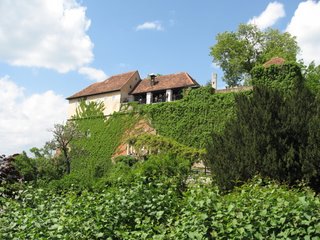 The Stallbastei on the Schlossberg, Graz
The Stallbastei on the Schlossberg, GrazIn 2003 Graz was the European capital of culture. To celebrate, several new buildings were erected including one constructed as an artificial island in the river. Made from glass and steel it provides a restaurant, auditorium, radio station and children's play area. It is in the form of a mussel shell and is in complete contrast to the beautiful baroque facades and domes of the old town. There is another building of the same date, constructed from similar materials known as the Friendly Alien. This is now used as a modern art gallery, restaurant and conference venue.
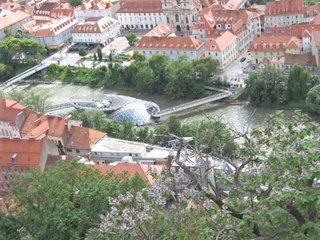 The Acconci Island on the Mur seen from the Schlossberg, Graz
The Acconci Island on the Mur seen from the Schlossberg, Graz The Friendly Alien from the Schlossberg, Graz
The Friendly Alien from the Schlossberg, GrazNext we explored a couple of parks – the Burggarten and the Stadtpark - crowded with young people lying on the grass, reading, chatting, or riding their bikes down the shady tree-lined avenues between the formal flower gardens and fountains. Here we stopped to rest on a bench and ended up falling asleep we were so weary with wandering!
 The fountain in the Stadtpark, Graz
The fountain in the Stadtpark, GrazAcquired from the World Exhibition in Vienna in 1873
Refreshed we sallied forth into the fray to visit the Cathedral. This has a beautiful Baroque interior where everything co-ordinates. Pews and lectern are in polished, inlaid mahogany while altar rails, side chapels and floors are in warm red marble. There is a massive and beautiful organ which we were fortunate to hear being played as we wandered around. Throughout the cathedral there is lavish use of gold which contrasts well with the white rendered walls. Outside on the south wall is a fresco painted in 1485 to commemorate the city being freed from 3 different plagues in 1480. These were the plague, locusts and Turkish tyranny.
 A free concert on the magnificent Cathedral organ, Graz
A free concert on the magnificent Cathedral organ, Graz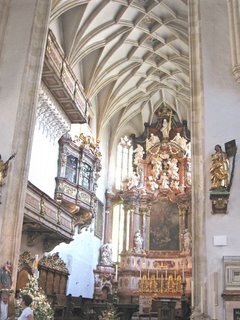 Baroque splendour in a Gothic setting, Graz Cathedral
Baroque splendour in a Gothic setting, Graz CathedralBeside the Cathedral stands the mausoleum, dating from 1615, with its large green copper domes, where the tomb of Emperor Ferdinand II is housed. Finally, Ian dragged a protesting Jill, to see the Opera house swathed in sheeting as it is being restored, and the glockenspiel where a couple of automatons come out at 6pm to do whatever is expected of them. As it was still only 5.30pm and even Ian was exhausted, we have left this treat for another day.
 The Mausoleum of Ferdinand II, Graz
The Mausoleum of Ferdinand II, Graz Jill's hopes are dashed as the historic baker's shop is closed, Graz
Jill's hopes are dashed as the historic baker's shop is closed, GrazOn the streets of Graz we have been saddened to see a great number of people from Eastern Europe sitting in doorways and begging. Within just a few yards we passed half a dozen people, young and old. Some of the younger ones play the accordion in an attempt to earn a few coins, while other sit confined to wheelchairs or with young children beside them. It is a worrying sight and we have no idea whether there is any aid for such people offered by the Austrian government. Nor do we know exactly where they have come from or what persecution lead them to seek alms on the streets of this city.
Back at the campsite we were astonished to discover it had filled up during the day and is now really crowded. We went for a stroll around the huge swimming pool with its bar and terrace, included as part of this campsite. Nobody was swimming however and the air had turned chilly after sunset. So we opted for wine in Modestine instead where, with the aid of a map, we have sorted out what to do tomorrow as we wait to see Mike and Vicki on Saturday.
Friday 26th May 2006, Graz, Austria
Already at 8am it was hot as we did some emergency shopping at the local supermarket, open again after yesterday's national holiday. Having travelled through so many different countries recently and spent sufficient time in each to require us to shop for food, it is really interesting to see just how different the national lifestyles are in the countries of Europe. On the surface we are all very similar but eating habits really do differ from country to country. In our local supermarket here we found very few tinned products, jars being used and recycled. There was little in the way of fresh meat but rows and rows of different types of sausages including dried and spicy ones, frankfurters and others for grilling or boiling – bratwurst and bockwurst. Yogurts and butter are popular but there is little in the way of cheeses or cream. Pickled vegetables and sauerkraut are stacked high and enormous bottles of tomato ketchup, mayonnaise and mustard were being bought. Fresh white rolls were baked on the premises – bread in Italy was really awful. Dark brown rye bread that keeps for weeks is also popular. Cakes and biscuits are fairly boring and dry but a significant improvement on Italy which seems to live on little else than pasta and pizza.
In Spain and Portugal we found mountains of dried and salted cod and their deep freezers were filled with paella, cuttlefish, octopus and squid. In France the freezers were filled with duck, foie gras, mussels and oysters. In Italy they all seemed full of multicoloured ice cream and here they are filled with whole cabbages that have been vacuum packed and then deep frozen! How can a nation lavish so much care on a cabbage? Our shopping bill though, including a couple of bottles of Austrian wine, was significantly less than a similar basket of essentials purchased in Italy which we found rather expensive.
Today we took the bus across Graz to the Eggenberg castle and we have had a very pleasant day. The castle stands in a rural setting on the edge of the city in beautiful grounds. Near the entrance we discovered a restaurant with tables outside under the trees serving an "eat 'til defeat" menu. There was no choice, you paid your 6.50 euros and helped yourself. Vegetable soup, deep fried mushrooms and tartar sauce, lasagne with courgettes and onions and a bowl of fresh salad. With this we drank half litre tankards of beer! We'd best not stop in Austria for long. The food and drink is just too good, too cheap and too plentiful!
The castle at Eggenberg was originally constructed in the 15th century but reworked and extended after 1625 by Duke Hans Ulrich, chief advisor to the Emperor Ferdinand II. His Grand Design was to create an ideal world with four towers to represent the seasons, fifty two rooms for the weeks of the year and 365 windows for the days. Guided tours of the state rooms were obligatory and as they were in German there was much Jill did not fully appreciate. The rooms were lavish with glass chandeliers and ornate gilded mirrors. The walls were completely covered in paintings and frescoes, many representing scenes from Greek mythology. The ceilings were likewise decorated by more than 600 paintings with much use of allegoric symbolism, often intended to emphasise the status of the family. In the main room, the Planetensaal for example, there were ceiling paintings depicting the planets and the four elements. We were hustled through twenty four rooms representing the hours of the day - twelve with light doors and twelve with dark to represent the night hours - in fifty minutes so there is not a great deal that can be gleaned from two minutes a room! Unfortunately we were not allowed to take any photographs of the interior.
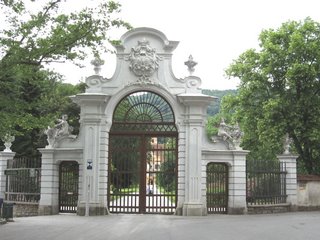 Gateway to the castle grounds, Eggenberg, Graz
Gateway to the castle grounds, Eggenberg, Graz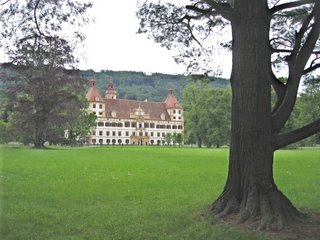 Schloss Eggenberg, Graz
Schloss Eggenberg, Graz Peacocks on guard at the castle entrance, Eggenberg, Graz
Peacocks on guard at the castle entrance, Eggenberg, Graz Courtyard of the castle, Eggenberg, Graz
Courtyard of the castle, Eggenberg, GrazThere are several museum galleries in the castle, which we browsed in a more leisurely way. These covered local pre-history and a superb art collection of mediaeval paintings and sculptures of a religious nature including a couple of works by Lucas Cranach, and a Renaissance and Baroque gallery which included works by Pieter Brueghal the Younger. The medieval exhibits were beautifully lit to bring out the religious emotion of the subjects.
We were particularly fortunate to see an exhibition of what must be the equivalent of our Sutton Hoo burial, but one thousand years older. The grave goods of the local Hallstatt ruler, who died in the sixth century BC included armour, pottery and metal containers which were chased with scenes of courtly life. They had all been meticulously restored and are due to go on a world tour. They had been discovered in the delightfully named village of Kleinklein (Littlelittle).
The surrounding parkland with its peacocks was cool and beautiful for a stroll after we eventually emerged from the art collections and before catching the bus which dropped us back right near the campsite.
 White peacock displaying, Eggenberg, Graz
White peacock displaying, Eggenberg, GrazSaturday 27th May 2006, Graz, Austria
By special request the stars of today's blog are Mike and Vicki Maguire, longstanding friends and former work colleagues from Exeter.
Today has been a really happy day spent with them around Mike's native town of Graz. Until a chance comment in an email the day before we arrived here we had no idea we would all be here together. It has been a real delight for us, so far from home, to find ourselves unexpectedly with such good friends.
 Friends reunited, Mike and Ian in Graz
Friends reunited, Mike and Ian in GrazToday was their only free day during a brief visit to take part in a family celebration. Mike was determined we should all enjoy Graz and its culinary delights to the full, so today has been given over almost exclusively to an Austrian gastronomic fest! Once we had met up under the tall maypole in front of the town hall we were guided to Mike's favourite open air food-stall in the Hauptplatz selling hot sausages with mustard and grated horseradish. The city trams passed by inches from our ankles, while a group of eccentric young men gathered a crowd around them as they spun endlessly upside down on their heads in the centre of the square lined with wonderful 17th century baroque buildings.
Next we were guided down the main street to the Temmel ice cream stand. Mike had been dreaming for weeks of an apple and cinnamon water ice and his moment had finally arrived! The people of Graz seem as fond of their ices as the Italians. Certainly we found their tiramisu and pistachio ices delicious and we presume Mike enjoyed his as he managed to slip off back for another one while we were looking the other way!
 The other ice cream!
The other ice cream!There is a gilded statue on top of a column by a fountain at the end of the main street. Beside it is a lift in a glass cage that just goes up and down. It is "a highway to nowhere" in the true sense of the phrase! It costs a euro for this pointless delight so all four of us squashed in and up we went, ice creams and all. Well at least we got a view up the main street and looked the gilded statue in the eye!
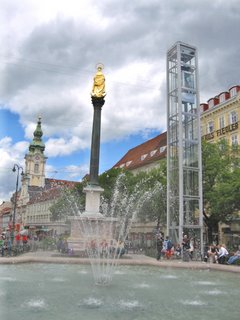 Highway to nowhere, Graz
Highway to nowhere, Graz Herrengasse from the top of the glass lift, Graz
Herrengasse from the top of the glass lift, GrazWe'd been so enthralled by this experience we needed a rest so we happily followed Mike to his favourite Konditorei for coffee, Austrian chocolate cake and mountains of whipped cream. This really was a delightful experience and it blended so well with the ice cream, sausage and horseradish!
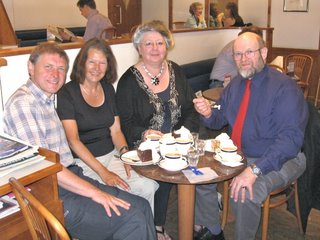 Are there any librarians left in Exeter? Maguires and Maxteds in a Konditorei in Graz
Are there any librarians left in Exeter? Maguires and Maxteds in a Konditorei in GrazWe forgot to mention that Mike had recently acquired a new, state of the art digital camera and throughout the day he has been putting it through its paces by taking close-up pictures of anything that takes his fancy. This may possibly be a building or statue, it may even be one of us, it is more likely to be an ant on somebody's shoulder, a flower in the park, a caraway seed on the table cloth, or his own refection seen in a close-up of Jill's eyeball. Suffice to say, he was completely enthralled by his new toy and he should have some interesting photos to show to work colleagues back at Exeter Library next week.
 Mike in a typical pose, Graz
Mike in a typical pose, GrazAfter all this eating and coffee drinking some of us were beginning to feel hungry! We strolled along the main street, pausing at all the camera shops for Mike, the clothes and jewellery shops for Jill and Vicki and the books and prints shops for Ian. At the little cable railway we were taken up the steep cliff face to the castle with the lovely views over the town described the other day. We had to share the lift with a wedding couple who had just got married in the town hall below and were going, with their bridesmaids and guests to the reception in the castle restaurant.
 Graz goes sweet on Mozart
Graz goes sweet on Mozart Cliff railway, Graz
Cliff railway, GrazWe opted for lunch on the restaurant terrace under a shady tree with a view down onto the city. Beyond we could enjoy a vista of wooded hills rising into the distance where the higher reaches were still snow covered. Austrian beer accompanied our Wienerschnitzel und Kartoffelsalat mit Kurbissöl und Petersilie. (veal cutlet with potato salad dressed with pumpkin seed oil and fresh parsley.)
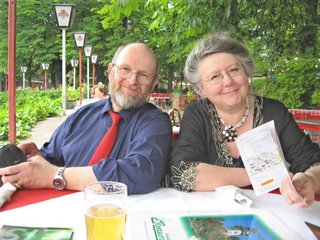 Mike and Vicki released from work
Mike and Vicki released from work Jill and Ian even more released from work
Jill and Ian even more released from workLater we wandered slowly through the castle gardens, Vicki, Ian and Jill chatting together as we waited for Mike to photograph a leaf here, a raven in a tree there, and the bottom of a well somewhere else.
 Vicki waits patiently for Mike to adjust his camera, Graz
Vicki waits patiently for Mike to adjust his camera, Graz Jill helps Mike to investigate the photographic potential of the castle well, Graz
Jill helps Mike to investigate the photographic potential of the castle well, Graz Jill on the Schlossberg, Graz
Jill on the Schlossberg, GrazBack down in the town we went our separate ways, Jill and Ian to watch the wooden glockenspiel figures twist around the clock as the hour struck 6pm, Mike and Vicki to join their Austrian relatives for a family supper in their honour. We only hope they were able to do full justice to auntie's Austrian cooking after such an abstemious day!
 Glockenspiel, Graz
Glockenspiel, Graz Cathedral at Gemona di Friui
Cathedral at Gemona di Friui St. Christopher with Jill – and Jesus of course! Gemona di Friui
St. Christopher with Jill – and Jesus of course! Gemona di Friui Cathedral after the earthquake in 1976, Gemona di Friui
Cathedral after the earthquake in 1976, Gemona di Friui Cathedral thirty years on, Gemona di Friui
Cathedral thirty years on, Gemona di Friui Earthquake rubble still beside the path, Gemona di Friui
Earthquake rubble still beside the path, Gemona di Friui Town hall before and after the earthquake, Gemona di Friui
Town hall before and after the earthquake, Gemona di Friui Town hall today, Gemona di Friui
Town hall today, Gemona di Friui Lower of the lakes, Laghi di Fusine
Lower of the lakes, Laghi di Fusine Azure waters indeed! Laghi di Fusine
Azure waters indeed! Laghi di Fusine Lakeside wooden café. Laghi di Fusine
Lakeside wooden café. Laghi di Fusine A stroll around the lake, Laghi di Fusine
A stroll around the lake, Laghi di Fusine Retirement! Laghi di Fusine
Retirement! Laghi di Fusine Modestine at Laghi di Fusine
Modestine at Laghi di Fusine Wild flowers bluer than the waters of the lake! Laghi di Fusine
Wild flowers bluer than the waters of the lake! Laghi di Fusine Upper lake, Laghi di Fusine
Upper lake, Laghi di Fusine Modestine centre stage, Laghi di Fusine
Modestine centre stage, Laghi di Fusine Village church with apple blossoms, Podkoren, Slovenia
Village church with apple blossoms, Podkoren, Slovenia View from the top of the village, Podkoren, Slovenia
View from the top of the village, Podkoren, Slovenia Mountain pastures, Podkoren, Slovenia
Mountain pastures, Podkoren, Slovenia Landhaus, Klagenfurt
Landhaus, Klagenfurt Baroque architecture, Klagenfurt
Baroque architecture, Klagenfurt Baroque houses in the Alter Platz, Klagenfurt
Baroque houses in the Alter Platz, Klagenfurt Café near the lake, Klagenfurt
Café near the lake, Klagenfurt St. Mark's Cathedral, Venice together with the Eiffel Tower, Paris
St. Mark's Cathedral, Venice together with the Eiffel Tower, Paris Dreifaltigkeitsäule, Klagenfurt
Dreifaltigkeitsäule, Klagenfurt Chronogram on the Dreifaltigkeitsäule, Klagenfurt
Chronogram on the Dreifaltigkeitsäule, Klagenfurt Gustav Mahler's woodland retreat, Klagenfurt
Gustav Mahler's woodland retreat, Klagenfurt Evening on the Wörthersee, Klagenfurt
Evening on the Wörthersee, Klagenfurt